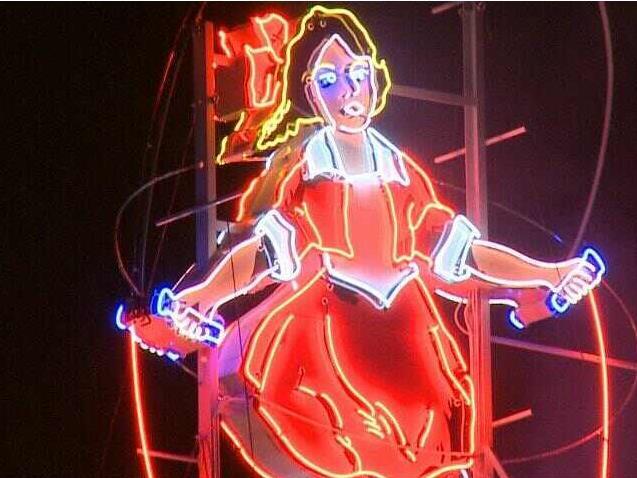‘I love’ are the first words heard in Neon. Indeed, other than the documentary’s title — taken from the colourless gas that glimmers so brightly in tubes and advertising signs — they may just be the film’s most uttered phrase. Writer/director Lawrence Johnston (Fallout) doesn’t hide his affection for his buzzing subject, and nor do his parade of talking-head interviewees. Even attempting to do so would’ve been impossible; people aren’t passive when it comes to the substance first harnessed for signage at the turn of the 20th century — they’re actively passionate about it.
Of course, drawing attention and sparking eagerness has always been neon’s ultimate aim as it lit up Parisian and then U.S. skies, and endeavoured to lure customers into stores, restaurants and more. That pioneering French engineer and inventor Georges Claude considered himself “the bringer of light” was fitting, with his creation literally brightening up everything it was associated with. Businesses, buildings, film titles and scenes, the entire marketing industry, Times Square as both a destination and a landmark: they all benefited from neon’s radiance. And in its heyday, so did everyone looking on, bewitched as they were not just by the desire to frequent shops, attend shows and buy products, but by a futuristic-seeming technology that dazzled with its candy-hued sheen, entranced with its animation, and enchanted with its warm, upbeat illumination.
Accordingly, Neon adoringly attempts to document, dissect, and understand a chemical element that became an glowing force, a longer-lasting alternative to existing light methods, a much-loved promotional and artistic phenomenon, and an unmistakable beacon of the American dream as a result. And what better way to do so than to splash as many neon signs as possible onto the screen courtesy of archival footage, modern-day tours, and a visit to Las Vegas museum The Boneyard; and chat with an army of aficionados about the history, evolution, gradual dimming in popularity, and eventual fading out of their favourite shining signage and sculptural product — designers, artists, activists, critics, curators, photographers, and architects among them.
In fact, for Johnston’s return to darkened skylines after 2007’s Night, and to methods of public communication after 1994’s Eternity, the filmmaker smartly lets his point of focus monopolise the screen. ‘I always felt that neon was alive,’ explains Kim Koga, executive director of the Museum of Neon Art on Los Angeles, as Neon winds down, with her statement encapsulating the documentary’s entire perspective. With cinematographer Eron Sheean largely keeping his camera static — or slowly sweeping over a selection of neon beauties at times — it’s left to the titular substance itself to add colour and movement. It may an obvious stylistic choice, as well as a simple one; however it also proves intoxicatingly effective.
In addition, it’s an approach that never lets the reality that Neon is a love letter first and foremost fall out of the viewer’s mind. While such devotion can’t always patch over the straightforward nature of Johnston’s delivery of information, it can explain it. In the feature, and to all the fans that offer their thoughts within its frames, neon truly does shine brightest. Consequently, a vibrant subject begets a lively, jazzily-scored documentary chronicle that’s standard in its compilation of discussions and images, but energetic and infectious in its enthusiasm.
Rating: 3 stars out of 5
Neon
Director: Lawrence Johnston
Australia, 2015, 84 mins
Release date: 2 June
Distributor: Ronin Films
Rated: PG
Actors:
Director:
Format:
Country:
Release:





